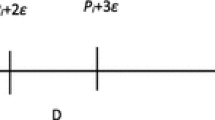Abstract
The sequential Hotelling's duopoly model on a tree was studied by Eiselt (1992), who developed conditions for the existence of location equilibria when location decisions are nodes and prices are parametric. In this paper, this competition model is also analyzed, but considering that locations for the two firms can be any pair of points on the tree, nodes or points in the edges. First, a condition is given under which both the leader and the follower get a positive profit. In this setting, the problem of finding optimal locations for each of them is studied with different and equal prices. In both cases, the set of optimal locations for the follower is generated for any location of the leader as well as the set of optimal locations for the leader. As a consequence the entire set of Stackelberg solutions to this competition model is obtained.
Similar content being viewed by others
References
Badhury, J., H.A. Eiselt, and J.H. Jaramillo. (2003). “An Alternating Heuristic for Medianoid and Centroid Problems in the Plane.” Computers and Operational Research 30, 553–565.
Benati, S. and G. Laporte. (1994). “Tabu Search for the (r-Xp) Medianoid and the (r-p) Centroid Problems.” Location Science 2, 193–204.
Brandeau, M.L. and S.S. Chiu. (1994). “Location of Competing Facilities in a User-Optimizing Environment with Market Externalities.” Transportation Science 28, 125–140.
Drezner, T. (1994a). “Locating a Single New Facility among Existing Unequally Attractive Facilities.” Journal of Regional Science 34, 237–252.
Drezner, T. (1994b). “Optimal Continuous Location of a Retail Facility, Facility Attractiveness, and Market Share: An Interactive Model.” Journal of Retailing 70, 49–64.
Drezner, Z. (1982). “Competitive Location Strategies for Two Facilities.” Regional Science and Economics 12, 485–493.
Drezner, Z. (1995). Facility Location: A Survey of Applications and Methods. Berlin: Springer.
Drezner, T. and Z. Drezner. (1998). “Facility Location in Anticipation to Future Competition.” Location Science 6, 155–173.
Eiselt, H.A. (1992). “Hotelling's Duopoly on a Tree.” Annals of Operations Research 40, 195–207.
Eiselt, H.A. and G. Laporte. (1989a). “Competitive Spatial Models.” European Journal of Operational Research 39, 231–242.
Eiselt, H.A. and G. Laporte. (1989b). “The Maximum Capture Problem in a Weighted Graph.” Journal of Regional Science 29, 433–439.
Eiselt, H.A. and G. Laporte. (1991). “Locational Equilibrium of Two Facilities on a Tree.” RAIRO 25, 5–18.
Eiselt, H.A. and G. Laporte. (1996). “Sequential Location Problems.” European Journal of Operational Research 96, 217–231.
Friesz, T., T. Miller, and R. Tobin. (1988). “Competitive Network Facility Location Models: A Survey.” Papers of the Regional Science Association 65, 47–57.
Gabszewicz, J.J. and J.F. Thisse. (1992). “Location.” In R. Aumann and S. Hart (eds.), Handbook of Game Theory with Economic Applications. Amsterdam: Elsevier Science Publishers, pp. 281–304.
García, M.D. and B. Pelegrín. (1997). “Two-Stage Competitive Location on a Tree.” Studies on Locational Analysis 11, 101–114.
Goldman, A.J. (1971). “Optimal Center Location in Simple Networks.” Transportation Science 5, 212–221.
Hakimi, S.L. (1983). “On Locating New Facilities in a Competitive Environment.” European Journal of Operational Research 12, 29–35.
Hakimi, S.L. (1986). “p-Medians Theorems for Competitive Location.” Annals of Operations Research 5, 79–88.
Hakimi, S.L. (1990). “Locations with Spatial Interactions: Competitive Locations and Games.” In: P. Mirchandani and R. Francis (eds.), Discrete Location Theory. New York: Wiley-Interscience, chapter 10, pp. 439–478.
Miller, T., T. Friesz, and R. Tobin. (1996). “Equilibrium Facility Location on Networks.” Berlin: Springer.
Plastria, F. (2001). “Static Competitive Facility Location: An Overview of Optimisation Approaches.” European Journal of Operational Research 129, 461–470.
Prescott, E.C. and M. Visscher. (1977). “Sequential Location among Firms with Foresight.” Bell Journal of Economics 8, 378–393.
ReVelle, C. (1986). “The Maximum Capture or Sphere of Influence Problem: Hotelling Revisited on a Network.” Journal of Regional Science 26, 343–357.
Serra, D. and C. ReVelle. (1994). “Maximum Capture by Two Competitors: The Preemptive Capture Problem.” Journal of Regional Science 34, 549–571.
Serra, D. and C. ReVelle. (1999a). “Surviving in a Competitive Spatial Market: The Threshold Capture Model.” Journal of Regional Science 39, 637–652.
Serra, D. and C. ReVelle. (1999b). “Competitive Location and Pricing on Networks.” Geographical Analysis 31(2), 109–129.
Author information
Authors and Affiliations
Rights and permissions
About this article
Cite this article
García Pérez, M.D., Pelegrín, B.P. All Stackelberg Location Equilibria in the Hotelling's Duopoly Model on a Tree with Parametric Prices. Annals of Operations Research 122, 177–192 (2003). https://doi.org/10.1023/A:1026150608051
Issue Date:
DOI: https://doi.org/10.1023/A:1026150608051




